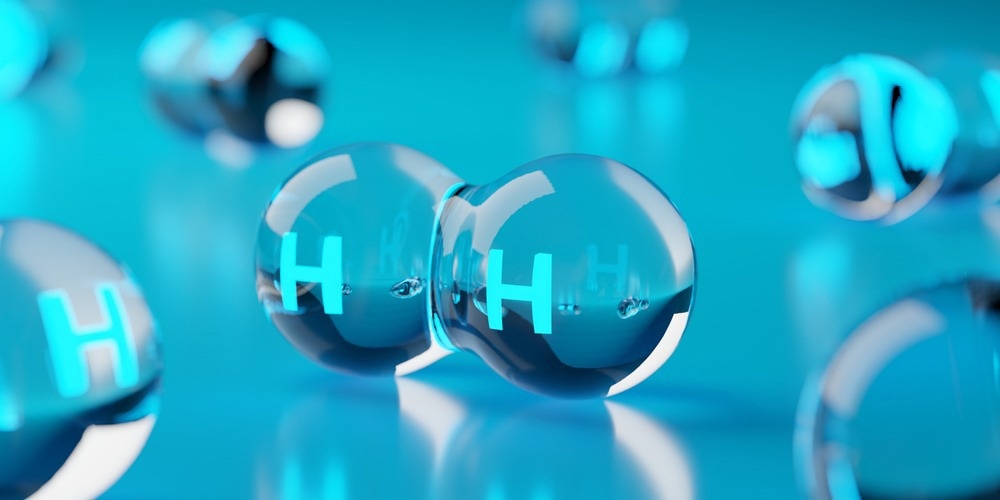In an article recently published in the journal ACS Applied Energy Materials, researchers discussed the utility of Ti3C2 MXene quantum dots/1D CdS nanorod doped with nitrogen photocatalyst with highly efficient hydrogen evolution in the heterostructure.

Study: Nitrogen-Doped Ti3C2 MXene Quantum Dots/1D CdS Nanorod Heterostructure Photocatalyst of Highly Efficient Hydrogen Evolution. Image Credit: Shawn Hempel/Shutterstock.com
Background
Solar-driven photocatalytic breakdown of water for hydrogen synthesis technology is a desired renewable energy solution to combat the acute energy problem. It has taken tremendous work and substantial advancements to enable photocatalytic materials' extremely effective hydrogen evolution capabilities.
Creating extremely effective and stable hydrogen evolution photocatalytic materials continues to be a highly desired strategy.
A potential study focus for photocatalytic water splitting is cadmium sulfide (CdS). However, extensive research has shown that fast photoinduced carrier recombination is possible in CdS and is a significant photo corrosion phenomenon that severely hampers photocatalytic hydrogen synthesis productivity.
To achieve high-efficiency photocatalytic water splitting, rationally altering CdS to create advanced composite photocatalytic materials would be the best course of action. When used in conjunction with cocatalysts to build heterojunctions, photocatalysts have been regarded as a successful method for increasing the efficiency of photocatalytic hydrogen production because they can prevent the recombination of photocarriers.
The innovative Ti3C2 MXene is a two-dimensional (2D) layered material with exceptional physicochemical stability, outstanding electron conductivity, and abundant active catalytic sites.
In recent years, the research focus has shifted to producing quantum dots from materials with 2D MXene layer structures. The high electron coupling effect and close interaction can significantly increase the efficient transfer and separation of photocarriers at the heterojunction surface.
Functional Heterostructure Photocatalyst
In this study, the authors discussed the development of a functional heterostructure photocatalyst made of nitrogen-doped Ti3C2 MXene quantum dots (N-MQDs) supported rationally on a 1D CdS nanorod.
N-MQDs/CdS displayed superior performance for photocatalytic hydrogen synthesis with an efficiency rate of 17094 mol g-1 h-1. N-MQDs/CdS exhibited an effective activity for the photodegradation of phenol due to their strong oxidizing capabilities. The considerable performance improvement was primarily attributed to the synergistic interaction of the highly conductive Ti3C2 MXene quantum dots and 1D CdS nanorod's matching energy levels, which significantly increased the separation and transfer of photogenerated carriers.
The team demonstrated that the proposed materials could control the energy band structure of photocatalysts by using multifunctional MXene materials. A self-assembly method was devised to prepare novel NMQDs/CdS materials for photocatalytic hydrogen production by loading N-MQDs onto the surface of 1D CdS nanorods.
The researchers evaluated the performance of the novel heterojunction photocatalyst in photocatalytic H2 generation under visible light. The efficiency of producing hydrogen was 14.79 times higher than that of pure CdS nanorods. The excellent carrier separation efficiency generated by the exceptional heterojunction could cause an apparent enhancement in photocatalytic activity. The findings showed that Ti3C2 MXene quantum dot was a powerful cocatalyst for photocatalytic H2 production.
Observations
The valence band of pure CdS and N-MQDs/CdS was 1.61 and 1.74 V, respectively.
Pure CdS and N-MQDs/CdS had flat-band potentials of -0.93 and -0.66 V, respectively, and the conduction band position (ECB) was further determined to be -0.79 and -0.52 V, respectively.
N-MQDs/CdS and CdS had different Fermi energy levels (EF) of 1.64 eV and 1.43 eV, respectively. When exposed to N-MQDs/CdS-3.0% for 120 minutes, the mineralization rate increased to 91.36%, but pure CdS mineralization for phenol was only 25.67%. According to the results of the total organic carbon (TOC) experiments, the composite made of N-MQDs and CdS at a percentage of 3.0% significantly affected phenol's mineralization.
N-MQDs/CdS-3.0% had a kinetic rate of 0.0306 min-1 of phenol degradation, which was 12.41 times higher than pure CdS.
Only 39.04% of the phenol pollutant was photodegraded in 120 minutes in the case of pure CdS.
The composite N-MQDs/CdS-3.0% demonstrated outstanding photocatalytic degradation activity of 98.36% within the same irradiation period. The addition of NMQDs considerably improved the hydrogen production efficiency of N-MQDs/CdS and reached 17094 μmol h-1 g-1 under visible light. N-MQDs/CdS heterojunction photocatalyst had 14.79 times the hydrogen evolution activity of pure CdS.
The fitted charge transfer resistance of N-MQDs/CdS-3.0% was only 3.57, significantly less than that of pure CdS photocatalysts. The presence of three peaks in the N 1s spectrum at 397.7, 398.6, and 399.6 eV, supported the efficacy of nitrogen doping.
Promoting Photocatalytic H2 Evolution
This study elucidated the development of a functional NMQDs/CdS heterostructure composite to promote photocatalytic H2 evolution.
The developed stable photocatalysts demonstrated exceptional photogenerated carrier separation and transfer capacity owing to the synergetic effect and robust interface interaction. The charge utilization was improved by the tight interfacial effect between N-MQDs and the CdS nanorods, which inhibited the quick recombination of photoinduced carriers.
N-MQDs/CdS-3.0% heterostructure composite exhibited superior hydrogen production of 17094 μmol h-1 g-1 and an effective photodegradation rate of more than 12.41 times and 14.79 times compared to the pristine CdS nanorods.
The authors mentioned that the proposed quick and efficient preparation method opens up a new avenue for the conception and design of effective photocatalysts based on the quantum dots of MXene for converting solar energy.
References
Ding, L., Zeng, S., Zhang, W., et al. (2022) Nitrogen-Doped Ti3C2 MXene Quantum Dots/1D CdS Nanorod Heterostructure Photocatalyst of Highly Efficient Hydrogen Evolution. ACS Applied Energy Materials. https://pubs.acs.org/doi/10.1021/acsaem.2c02001
Disclaimer: The views expressed here are those of the author expressed in their private capacity and do not necessarily represent the views of AZoM.com Limited T/A AZoNetwork the owner and operator of this website. This disclaimer forms part of the Terms and conditions of use of this website.